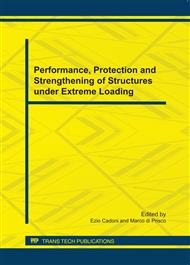[1]
A. Gosh, Ceramic International, (2007) pp.821-825.
Google Scholar
[2]
Ali Nazari, Shadi Riahi, Energy and Buildings, Vol. 43 (2011), pp.995-1002.
Google Scholar
[3]
Banarjee. S, Gopal. J, Physics and chemistry of photo catalytic Titanium-di-oxide, Current Science, Vol. 90, p.10.
Google Scholar
[4]
Carp. O, Huisman, Photo induced reactivity of TiO2 progress in solid state, Vol. 32, pp.33-177.
Google Scholar
[5]
Djamschid Amirzadeh, U.S. Patent, Use of TiO2 Residues from Sulphate process Vol. 6 (2003), pp.660-673.
Google Scholar
[6]
Gai, Fei, Peng, Song-Hua Bian, Construction and Building materials, Vol. 22 (2003), pp.593-599.
Google Scholar
[7]
Indian Standard, Methods of Physical Tests for Hydraulic Cement, (1968), pp.24-29.
Google Scholar
[8]
Kuhl, F.M. Lea, The Chemistry of Cement and Concrete, (Edward Arnold Publishers), London, pp.75-76.
Google Scholar
[9]
L.T. Phan, Fire performance of HSC concrete, a report of state of art. Maryland, Building and fire research laboratory, NIST (1996).
Google Scholar
[10]
Li Heii, Xiao Heii-gang, Micro Structure of Cement Mortar with Nano Particles, Compos part B Eng, Vol. 35 (2004), pp.185-9.
Google Scholar
[11]
Mills. A, le Hunte. S, J. Photo chem photo bio A chem, Vol. 108 (1997), p.1.
Google Scholar
[12]
N. M. Khalil, Ceramic International, Vol. 33 (2005), pp.937-943.
Google Scholar
[13]
Oktar, O. N., Moral. H, Tasdemir. M. A, Factors of determining the correlation between concrete properties, Cement and Concrete Research Journal, Vol. 26 (2008), pp.1629-1637.
DOI: 10.1016/s0008-8846(96)00167-6
Google Scholar
[14]
P. D. L. Mercera, J. G. Van Ommen, E. B. M. Doesburg, A. J. Burggraaf and J. R. H. Ross, Zirconia as a support for catalysts influence of additives on the thermal stability of the porous texture of Monoclinic Zirconia (Published by Elsevier B. V), Vol. 171, Issue. 2 (1991), pp.363-391.
DOI: 10.1016/0166-9834(91)85092-a
Google Scholar
[15]
V. Zivica, Bull Material Science, Vol. 20 (1997), pp.677-683.
Google Scholar
[16]
V.Antonovich, S.Goberis, The effects of different admixtures on property of refractory concrete with Portland cement ,Materials sciences, Vol. 9, (2003), p.4.
Google Scholar
[17]
Y. Kalpakli, U. S. Patent, Vol. 3, (1973), p.3773,531.
Google Scholar
[18]
Z. Zhao, J. P. Morniroli, A. Legris, A. Ambard, Y. Khin, L. Legras, M. Blat – Yrieix, Indentification and characterization of a new Zirconium Hydride, Journal of Microscopy, Vol. 232, Issue. 3 (2008), pp.410-421.
DOI: 10.1111/j.1365-2818.2008.02136.x
Google Scholar


